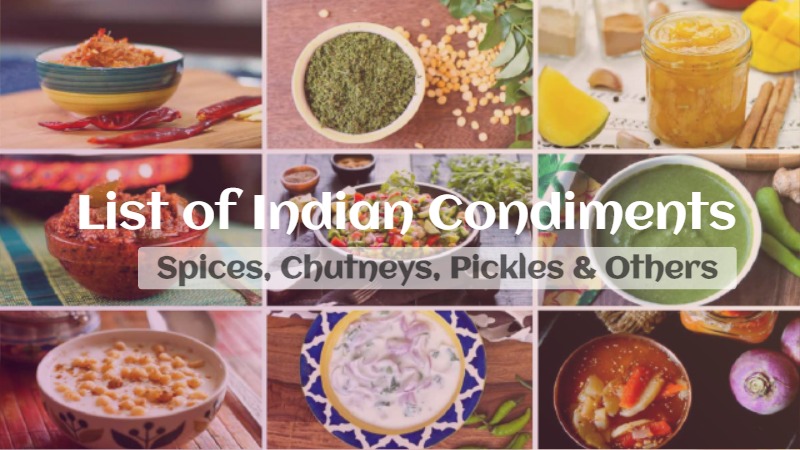
Indian condiments list comprises of a wide variety of chutney, raita and spices that are used to enhance the flavors of Indian dishes. These condiments are an integral part of Indian cuisine and are often served alongside main dishes, snacks, and street food. They add depth, heat, tanginess, and aromatic elements to the food, creating a harmonious balance of flavors. Here is an essential guide for spices, chutneys, achaar and many more.
Indian cuisine is renowned for its rich and diverse flavors and condiments play a significant role in enhancing the taste of various dishes. You can check the list of popular Indian condiments in this article, so read it till the end.
Indian Condiments List
The following is a list of condiments used in Indian cuisine:-
Dried Powders or Spices
Dried powders, also known as spices, are finely ground mixtures of dried herbs, spices, and other flavoring agents. They are commonly used in cooking to add flavor, aroma, and color to various dishes. Dried powders are versatile ingredients and are an essential part of many cuisines, including Indian cuisine. Here are some examples of dried powders:
- Ajwain – Derived from the seeds of the Ajwain plant, ajwain seeds have a strong and aromatic flavor. They have a sharp, peppery taste with a hint of bitterness. The flavor intensifies when the seeds are toasted or heated.
- Asafoetida (Hing) – Asafoetida is a pungent spice derived from the resin of a particular plant. It is used in small quantities to enhance the flavor of dishes, particularly in vegetarian cooking. Asafoetida has a strong aroma and adds a unique savory and umami taste.
- Black salt – Black salt, also known as kala namak or Himalayan black salt, has a unique flavor profile that is described as slightly eggy or sulfurous. It is used in chaats (Indian street snacks), chutneys, and spice blends. It is often used as a finishing touch or sprinkled on fruits, salads, and yogurt-based dishes for a savory and tangy flavor.
- Cardamom powder – It is a spice derived from the seeds of the cardamom plant, which belongs to the Zingiberaceae family. Cardamom powder has a strong, sweet, and aromatic flavor with hints of citrus and spice. It adds a warm and refreshing taste to dishes. It is known for its antioxidant properties and is considered beneficial for oral health. Cardamom is also believed to have antibacterial and anti-inflammatory effects.
- Red chili powder – Red chili powder is made from dried and ground red chili peppers. It adds heat and color to dishes and is a staple spice in Indian cuisine. The level of spiciness can vary based on the type of chili used.
Coriander powder - Curry leaves – Curry powder is a blend of various spices and herbs, such as turmeric, cumin, coriander, fenugreek, and red chili powder. It is used as a base flavoring agent in Indian curries and dishes.
- Garam masala – Garam masala is a warming spice blend commonly used in Indian cuisine. It typically includes spices like cinnamon, cardamom, cloves, cumin, coriander, and black pepper. Garam masala adds a rich and complex flavor to dishes and is often added towards the end of cooking or sprinkled on top as a finishing touch.
- Chaat Masala – Chaat masala is a tangy and flavorful spice blend used in various street foods and snacks in India. It typically consists of amchur (dried mango powder), cumin, coriander, black salt, dried ginger, and other spices. Chaat masala adds a unique zing to dishes like chaat, fruit salads, and yogurt-based snacks.
- Sambar Powder – Sambar powder is a spice mix used in South Indian cuisine, particularly in the preparation of sambar—a lentil-based vegetable stew. It usually contains a combination of lentils, dried red chilies, coriander seeds, cumin seeds, fenugreek seeds, and other spices.
- Turmeric Powder (Haldi) – Turmeric powder is a bright yellow spice derived from the root of the turmeric plant. It has a warm and earthy flavor and is widely used in Indian cooking. Turmeric powder not only adds color but also imparts a distinct flavor and is known for its health benefits.
- Ginger Powder – Ginger powder is a spice made from dried and ground ginger root. Ginger powder possesses a warm, spicy, and slightly sweet flavor with a hint of citrus. It has a distinct aroma that is both pungent and fragrant. The flavor of ginger powder is more concentrated compared to fresh ginger, although the two can be used interchangeably in most recipes.
- Himalayan salt – It is considered one of the purest forms of salt available and is known for its distinctive pink color. It can be used in the same way as regular table salt, adding flavor to soups, stews, sauces, and grilled meats. It is also popular for use as a finishing salt, sprinkled on salads, vegetables, or grilled seafood to add a touch of visual appeal and mild saltiness.
- Jira (Indian cumin seeds) – Jeera seeds are tiny, elongated, and have a distinctive flavor and aroma. Cumin has a warm, earthy, and slightly nutty flavor with a hint of citrus. It adds a distinct aroma to dishes and is often described as being both savory and slightly sweet.
- Raai – Rye is a type of cereal grain commonly used in baking, particularly in bread-making. It is a member of the wheat family and has been cultivated for thousands of years. Rye has a distinct flavor that is earthy, slightly sweet, and sometimes described as tangy or sour. Rye bread, in particular, is known for its robust flavor and dense texture compared to bread made from wheat flour.
Chutneys
Chutneys are savory or sweet sauces which are typically made from a combination of fruits, vegetables, herbs, and spices. They can be sweet, spicy, or tangy. Let’s now take a look at some of the common types of chutneys:-
- Mint (Pudina) chutney – The main ingredient in mint chutney is fresh mint leaves, which are blended or ground to form a paste. Other common ingredients include cilantro (coriander leaves), green chilies, garlic, ginger, lemon juice, salt, and sometimes roasted cumin powder or chaat masala for added flavor. Mint chutney has a refreshing and tangy flavor with a distinct minty taste. It is often described as cooling, with a hint of spiciness from the green chilies. It is commonly served with appetizers like samosas, pakoras, kebabs, and tikkas, adding a burst of flavor to the fried or grilled snacks.
- Tamarind (Imli) chutney – The main ingredient in tamarind chutney is tamarind pulp. Other common ingredients include jaggery (or sugar), water, spices like cumin powder, ginger powder, and black salt. Some variations may include additional spices like red chili powder, chaat masala, or garam masala for added complexity. Tamarind chutney has a unique sweet and tangy flavor. It is a key component in popular street foods like chaats (savory snacks), samosas, pakoras, and dahi vadas. It can also be used as a dipping sauce for appetizers, such as kebabs or tikkas.
- Beetroot chutney – The main ingredient, as the name suggests, is beetroot. Other common ingredients include onions, garlic, ginger, green chilies, lemon juice, and spices like cumin, coriander, or mustard seeds. Some variations may include coconut, tamarind, or yogurt for added flavor and texture. Beetroot chutney has a unique combination of earthy sweetness from the beetroots and the sharpness of the other ingredients. It can be served with rice, roti (Indian bread), dosa (savory pancakes), or as a spread for sandwiches and wraps. Beetroot chutney also pairs well with grilled meats, cheese, and crackers.
- Coconut chutney – The main ingredient in coconut chutney is fresh coconut, either grated or chopped. Other common ingredients include green chilies, ginger, garlic, roasted chana dal (split chickpeas), curry leaves, tamarind pulp, and salt. Some variations may include roasted peanuts or cashews for added richness and texture. Coconut chutney has a rich, creamy texture and a mild coconut flavor. It is commonly served with idli (steamed rice cakes), dosa (savory pancakes), vada (lentil fritters), and uttapam (thick rice pancake). Coconut chutney can also be enjoyed with other snacks, such as bajji (fried fritters) or as a spread for sandwiches and wraps.
- Chammanthi Podi – It is also known as Idli Podi or Gunpowder, is a flavorful and spicy South Indian condiment typically served with idli, dosa, or other South Indian breakfast items.
- Coriander chutney – The main ingredient in coriander chutney is fresh coriander leaves, including the stems. Other common ingredients include green chilies, garlic, ginger, lemon juice, salt, and sometimes roasted cumin seeds or chaat masala for added flavor. Some variations may include mint leaves or yogurt to enhance the taste and texture. Coriander chutney has a fresh and herbaceous flavor with a pleasant tanginess. It is commonly used as a dipping sauce or condiment for Indian snacks like samosas, pakoras, kebabs, and chaats (savory street food). It can also be spread on sandwiches, wraps, or used as a marinade for grilling or roasting meats and vegetables.
- Garlic chutney – The main ingredient in garlic chutney is fresh garlic cloves. Other common ingredients include dried red chilies, sesame seeds, peanuts, tamarind pulp, salt, and sometimes spices like cumin or coriander seeds. Some variations may include additional ingredients like coconut or roasted gram (chana dal) for texture and taste. Garlic chutney has a strong and pungent garlic flavor. It is commonly served with Indian snacks like vada pav (a popular street food), bhajiyas (fritters), or pakoras. It can also be used as a spread on sandwiches, burgers, or rolls for an added kick. Garlic chutney can be added to curries, stir-fries, or marinades to infuse dishes with its intense flavor.
- Hang curd hari mirch pudina chutney (typical north Indian) – Hari Mirch Pudina Chutney is a popular Indian condiment made with yogurt (dahi), fresh green chilies (hari mirch) and mint leaves (pudina). It is known for its vibrant green color and spicy flavor.
- Lime chutney – The main ingredient in lime chutney is fresh limes or lemons. Other common ingredients include green chilies, ginger, garlic, sugar or jaggery, salt, and sometimes spices like cumin or mustard seeds. Some variations may include additional ingredients like roasted peanuts or coconut for added texture and flavor. Lime chutney has a tangy and citrusy flavor due to the use of fresh limes or lemons. It can be served with Indian snacks like samosas, pakoras, or kebabs, adding a burst of tanginess. Lime chutney also pairs well with grilled or roasted meats, seafood, and vegetables. It can be used as a dipping sauce, spread, or even as a marinade for added flavor.
- Mango (keri) chutney – The main ingredient in mango chutney is unripe mangoes. Other common ingredients include sugar or jaggery, vinegar or lemon juice, ginger, garlic, red chili powder, cumin seeds, mustard seeds, and salt. Mango chutney has a delightful balance of sweet and tangy flavors. It is commonly served with Indian snacks like samosas, pakoras, or bhajis. It can also be used as a dip for chips, a spread for sandwiches, or a side accompaniment for curries and rice dishes. Mango chutney can even be used as a glaze for grilled or roasted meats.
- Onion chutney – The main ingredient in onion chutney is onions, preferably red onions for their slightly sweet flavor. Other common ingredients include red chilies, tamarind, garlic, salt, and sometimes spices like cumin or mustard seeds. Onion chutney has a savory, slightly sweet, and tangy flavor. It pairs well with dosa (savory pancakes), idli (steamed rice cakes), vada (lentil fritters), and uttapam (thick rice pancake). Onion chutney can also be enjoyed with other snacks, such as samosas, pakoras, or as a spread for sandwiches and wraps.
- Saunth (Laal) chutney – It is also known as sweet tamarind chutney made from dried ginger and tamarind paste. The main ingredient in saunth chutney is tamarind pulp, which provides the tangy flavor. Other common ingredients include jaggery or sugar for sweetness, water, ginger, spices like cumin and coriander powder, black salt, red chili powder, and sometimes dried fruits like dates or raisins for added texture and taste. Saunth chutney has a balanced blend of sweet and tangy flavors. It is commonly served with snacks like samosas, pakoras, bhajis, or kebabs, providing a tangy and sweet contrast. Saunth chutney is also a key ingredient in chaats, such as pani puri, sev puri, or dahi vada.
- Tomato chutney – The main ingredient in tomato chutney is ripe tomatoes. Other common ingredients include onions, garlic, ginger, red chilies, mustard seeds, cumin seeds, curry leaves, tamarind, sugar or jaggery, and salt. Tomato chutney has a tangy and slightly sweet flavor, complemented by the spices and other ingredients. Tomato chutney can also be enjoyed with snacks like samosas, pakoras, or sandwiches. It can even be used as a sauce or topping for grilled meats, vegetables, or as a flavor base for curries.
Raita
Raita is a yogurt-based condiment that provides a cooling effect to balance the spiciness of Indian dishes. It often contains ingredients like chopped cucumbers, tomatoes, onions, mint, and spices such as cumin.
- Cucumber raita (a cucumber curd side-dish) – The main ingredient in cucumber raita is cucumbers. Other common ingredients include plain yogurt, roasted cumin powder, salt, black pepper, chopped mint leaves, and sometimes chopped cilantro or coriander leaves. Cucumber raita has a cool and refreshing flavor. The combination of yogurt, cucumbers, and spices creates a creamy and tangy taste. This raita pairs well with dishes like biryani, pulao, curries, kebabs, and even as a dip for flatbreads or pappadums.
- Boondi raita – The main ingredient of Boondi raita is yogurt and boondi which are small, crispy, and spherical chickpea flour balls. Boondi is made by frying a batter made from chickpea flour (besan) into small droplets. It is especially enjoyed with biryani, pulao, and other rice dishes. Boondi raita can also be served alongside spicy curries, kebabs, or as a cooling element in a thali (traditional Indian meal). It adds a crunchy and savory element to the meal.
- Avocado yogurt – The main ingredients in avocado yogurt are ripe avocados and plain yogurt. Additional ingredients may include lime or lemon juice, salt, black pepper, garlic, and herbs like cilantro or parsley for added flavor. The avocado yogurt has a creamy, velvety texture and a rich, mild flavor. It can be incorporated into a wide range of dishes and can be served as a dip for fresh vegetables, tortilla chips, or pita bread. Avocado yogurt also makes a great spread for sandwiches, wraps, or burgers. It can be used as a creamy dressing for salads or as a topping for tacos or grilled meats
Achaar (Pickles)
Indian pickles, also known as achar, are made by preserving vegetables or fruits in oil, vinegar, or brine. They are usually spicy and can range from mango pickle and lime pickle to mixed vegetable pickle. Indian pickles are tangy condiments made from vegetables, fruits, or even meat. Some popular varieties include:-
- Aam ka achaar (mango pickle) – The main ingredient in mango pickle is raw or ripe mangoes. Other common ingredients include mustard seeds, fenugreek seeds, turmeric powder, red chili powder, asafoetida (hing), salt, oil (commonly mustard oil), and vinegar or lemon juice. Some variations of mango pickle may also include additional spices like fennel seeds, nigella seeds, or cinnamon for added complexity. Mango pickle has a tangy, spicy, and savory flavor profile. It is commonly served with rice dishes like biryani, pulao, or curd rice. Mango pickle is also paired with flatbreads like paratha or roti, providing a spicy and tangy accompaniment. It can be used as a flavor enhancer for curries or as a condiment in sandwiches and wraps.
- Nimbu ka achaar (lime pickle) – The main ingredient in lime pickle is limes. Other common ingredients include mustard seeds, fenugreek seeds, turmeric powder, red chili powder, asafoetida (hing), salt, oil (often mustard oil), and sometimes vinegar or lemon juice. Lime pickle has a distinctive tangy, spicy, and sour flavor. It adds a burst of flavor to rice dishes like biryani, pulao, or curd rice. Lime pickle is also enjoyed with flatbreads, such as parathas or rotis. It can be used as a flavor enhancer in curries or mixed with yogurt to make a tangy dip or raita.
- Gajar aur hari mirch ka achaar (carrot and chilli pickle) – The main ingredients in carrot and chili pickle are carrots and chili peppers. Other common ingredients include mustard seeds, fenugreek seeds, turmeric powder, red chili powder, asafoetida (hing), salt, oil (often mustard oil), vinegar, and lemon juice. Carrot and chili pickle has a bold and intense flavor profile. It is commonly served alongside rice dishes like biryani, pulao, or curd rice. The pickle can also be enjoyed with flatbreads, such as parathas or rotis, or as a zesty accompaniment to snacks and sandwiches. It adds a burst of flavor to wraps, rolls, or chaat (Indian street food).
- Mixed Vegetable Pickle – The main ingredients in mixed vegetable pickle can vary based on personal preferences and availability of vegetables. Commonly used vegetables include carrots, cauliflower, green beans, bell peppers, radishes, and turnips. The pickle is typically seasoned with spices such as mustard seeds, fenugreek seeds, turmeric powder, red chili powder, asafoetida (hing), salt, oil (often mustard oil), and vinegar or lemon juice. Mixed vegetable pickle offers a delightful blend of flavors and textures. It can be served as a side dish or accompaniment to a meal, complementing dishes like rice, roti, paratha, or bread. The pickle can be added to sandwiches, wraps, or burgers to provide a tangy and spicy element. It can also be used as a topping for salads or mixed into yogurt to create a flavorful raita.
Other Indian Condiments
- Ghee: Ghee is clarified butter commonly used in Indian cooking. It adds a rich, nutty flavor to dishes and is an essential ingredient in many Indian recipes.
- Tamarind paste: Tamarind paste is a tangy and slightly sweet condiment made from the pulp of tamarind fruit. It is used in various Indian dishes, such as chutneys, curries, and sambar (a lentil and vegetable stew).
- Coconut milk: While not technically a condiment, coconut milk is often used in Indian cuisine to add creaminess to curries and gravies. It is extracted from grated coconut and provides a distinct flavor to dishes.
- Papadums: Papadums are thin, crispy lentil wafers or flatbreads that are typically served as an accompaniment or snack. They come in different flavors and can be roasted or fried.
- Kachumber: There are several types of kachumber including tomato kachumber, mango kachumber and punjabi piyaz.
These are just a few examples of the many Indian condiments and flavorings used in Indian cuisine. Each region of India has its own unique range of condiments, showcasing the country’s culinary diversity.










